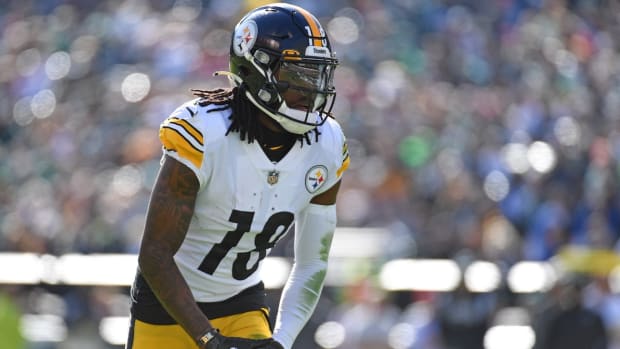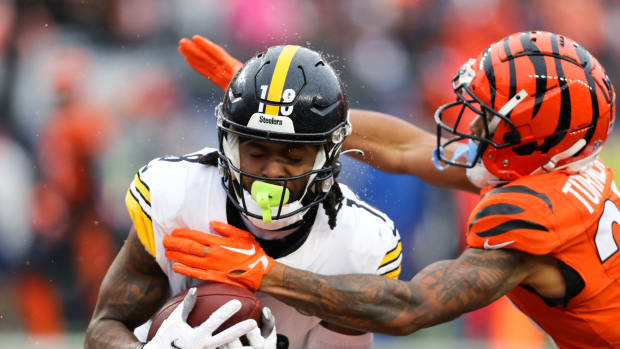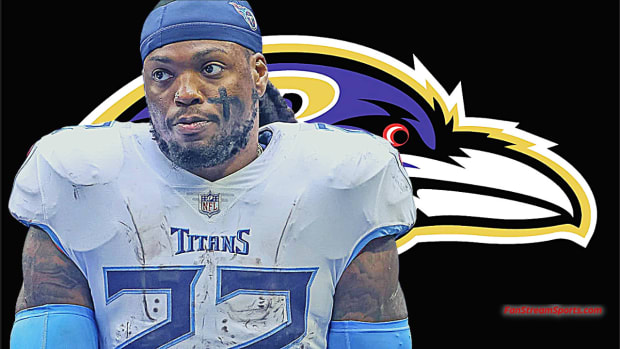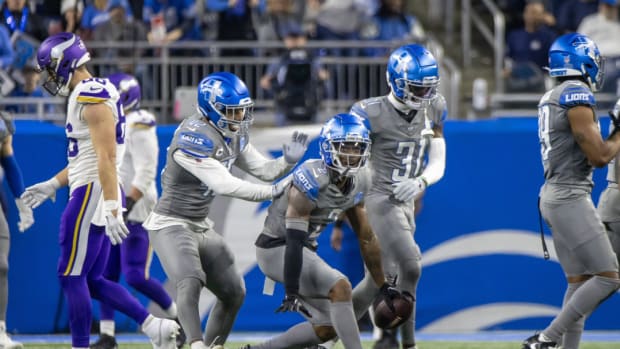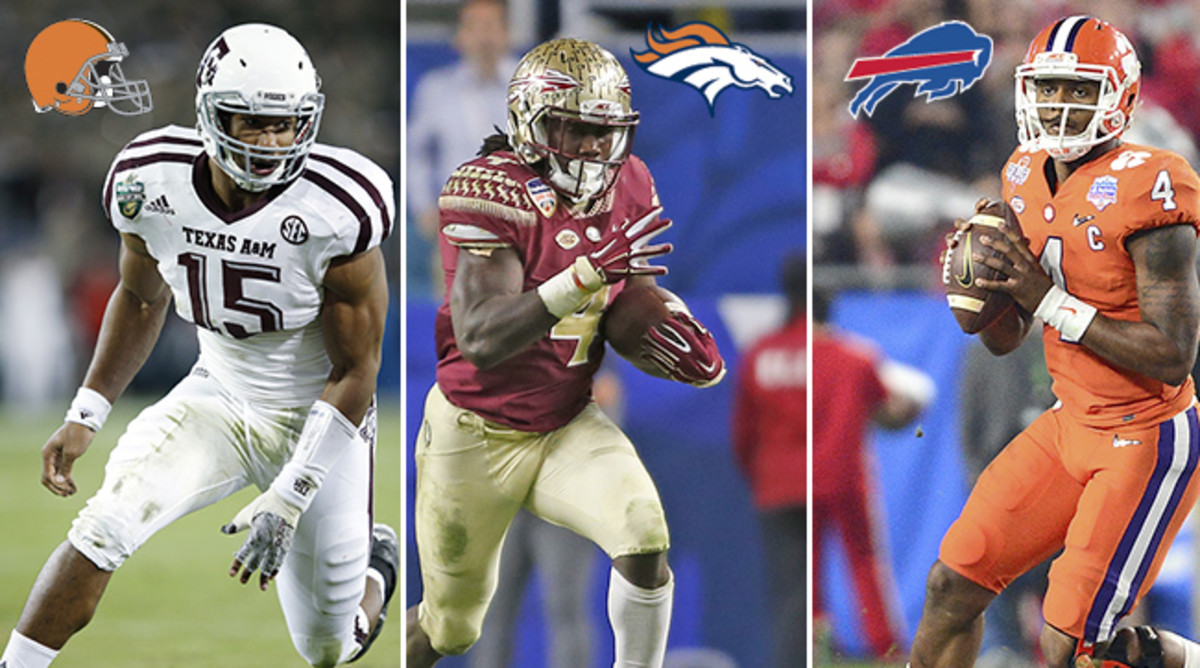
The College Column Mock Draft, Vol. 1
If you’re a first time reader of The College Column, welcome! Please check out the archive for enlightening profiles on some of the 2017 draft’s biggest names, as well as stories on some of this year’s most important trends. But for now, enjoy the first mock draft…
No. 1 Cleveland Browns: Myles Garrett, DE, Texas A&M
The Browns need a quarterback. But the Browns need a lot of things. They also have plenty of picks, and thus opportunities to fill deficiencies in later rounds. Should the Browns keep their top pick this season (and I think they will) it seems smart to go with a sure thing. What Cleveland really needs is a star. How good is Garrett? If he was eligible for the 2016 draft, he might have gone No. 1.
No. 2 San Francisco 49ers: Mitch Trubisky, QB, UNC
It’s hard picking for a team currently without a general manager or a coach, but we know the 49ers are trying to press reset on their organization. To begin, they’ll need a quarterback to build around. Trubisky, a junior with only one season as a starter in college, is not as polished as Jared Goff or Carson Wentz were at this point last year. But he has enough good traits (among his best: accuracy and arm strength) to get excited about. If Trubisky declares, I like him either here or in Chicago.
No. 3 Chicago Bears: Jonathan Allen, DL, Alabama
Missing out on Trubisky could be a blessing in disguise for the Bears. Yes, they need a quarterback, but in this year’s shallow class I think Chicago would be better off picking up someone in the second round who can sit for a year and learn behind a veteran (Miami’s Brad Kaaya, Texas Tech’s Pat Mahomes or Cal’s Davis Webb could all be great gets). Chicago needs offensive line and secondary help, but GM Ryan Pace can address that later. Allen might seem like a luxury pick, but hear me out: he would play opposite Akiem Hicks in Chicago’s 3-4. Imagine a front seven consisting those two, Leonard Floyd, Pernell McPhee and Danny Trevathan. Pace is almost done constructing an elite front seven. Finish the job, and it would cover up deficiencies elsewhere.
No. 4 Jacksonville Jaguars: Jamal Adams, S, LSU
Everyone applauded Dave Caldwell for winning last year’s draft (Jalen Ramsey and Myles Jack? Genius!). Though their 2016 season didn’t exactly play out as we all imagined, there’s no doubt Jacksonville has exciting young talent, which makes this one of the more desirable head coaching vacancies (even if you don’t know what to do with Blake Bortles). Adams has drawn comparisons to fellow-LSU secondary star Tyrann Mathieu—Adams is actually bigger, with school measurements of 6-feet, 211 pounds. Have Adams patrol a backfield featuring Tashaun Gipson and Ramsey? Perhaps 2017 is the year it all works out.
No. 5 Tennessee Titans (from Los Angeles): Marlon Humphrey, CB, Alabama
General manager Jon Robinson has built an offensive supporting cast that has allowed Marcus Mariota flourish. The run game is excellent—the offensive line is stout and Tennessee has the talented one-two running back punch every team covets. The only thing missing is a go-to-target in the receiving corps. This is a team in dire need of a WR1, so Clemson’s Mike Williams makes a lot of sense. However I think Robinson will wait and be rewarded (with the luxury of two top-20 picks). Instead, Tennessee will shore up its secondary with a stud cornerback in Humphrey.
No. 6 New York Jets: Leonard Fournette, RB, LSU
Mike Maccagnan to a best-player-available philosophy (see: Leonard Williams), and there’s no doubt Fournette is the most exciting player still on the board. The quarterback situation in New York is hazy as ever (drafting project quarterback Christian Hackenberg in the second round of 2016, then firing your quarterback coach and parting with your offensive coordinator one season later is not ideal). So let’s let the Jets shift—build around a once-in-a-generation RB talent like Fournette until they can figure it out at QB.
No. 7 San Diego Chargers: Malik Hooker, S, Ohio State
Hooker has only one season starting at Ohio State. Trust me when I say that doesn’t matter at all. During the entire year, scouts have been buzzing about the redshirt sophomore, who has drawn comparisons to Ed Reed. The Chargers need an heir apparent to Philip Rivers, and really need help on the offensive line. But general manager Tom Telesco won’t reach here. One of the reasons Telesco retained his job was because of his excellent 2016 draft class and I think he follows that up with an encore. Hooker is a stud.
No. 8 Carolina Panthers: Cam Robinson, OT, Alabama
We know general manager Dave Gettleman likes to build his team through the trenches, and it’s time to address the offensive side of that equation. Carolina’s run game was non-existent this year. Cam Newton needs help. It’s not a particularly strong year for offensive linemen, but Robinson would hold up in any class. It might seem like a reach (and you might see Gettleman try to trade down) but I don’t think he should overthink this: select the best offensive lineman available, and move on.
• NFL PLAYOFFS: Eli Manning Is Tougher Than You—Tim Rohan on the NFL’s unexpected Iron Man
No. 9 Cincinnati Bengals: Derek Barnett, DE, Tennessee
The Bengals need a lot of help with the pass rush, and shoring up the edge with a dynamite complement to Carlos Dunlap would do wonders. Barnett has been a productive force for the Volunteers, and though some scouts wonder if his stats are gaudier because of the way Tennessee manipulates his matchup, you can’t knock the guy for finding tackle for loss opportunities—and finishing them.
No. 10 Buffalo Bills: Deshaun Watson, QB, Clemson
It’s been an ugly week in Western New York, and when the dust settles—with a new head coach—I think Buffalo is ready to make the leap. There’s talent on the Bills’ roster, the only thing they haven’t been able to figure out is quarterback. It looks like Tyrod Taylor’s time in Buffalo may be done. Doug Whaley whiffed on EJ Manuel, and will try to right that wrong by selecting Watson here.
No. 11 New Orleans Saints: Takkarist McKinley, LB/DE, UCLA
The Saints must address their pass rush (or lack thereof). McKinley is one of the college football season’s biggest risers. Here’s what one of The College Column’s Anonymous Scouts said about McKinley in October: “Terrific speed off the edge. Perfect for a 3-4 linebacker in the NFL. Could be the next DeMarcus Ware. Freak athlete. Ran a 10.58 in the 100-meter.” Tell me he doesn’t sound like a good fit for New Orleans.
No. 12 Cleveland Browns (from Philadelphia): DeShone Kizer, QB, Notre Dame
We know the Browns passed on Carson Wentz last season. Whether that was the right decision remains to be seen. We know the Browns still need the guy—and a lot of guys. After prudently passing on a quarterback with the top pick, I see the Sashi Brown brain trust falling in love with Notre Dame’s Kizer, an Ohio native who has poise in the pocket but can threaten in other ways, too. When I wrote about Kizer in September, one quote from Brady Quinn stuck with me: “You see a lot of natural athletes who play quarterback because they can throw the football and they’re fast and athletic and they can get a coach out of a bad call because they can scramble. DeShone can get out of the pocket and run, but he’s a natural passer. He can pass with different anticipations, different speeds.”
No. 13 Arizona Cardinals: Reuben Foster, LB, Alabama
The Cardinals could use some secondary help, and I also hope they find an heir apparent to Carson Palmer somewhere in the later rounds. But with their first-round pick, I think a play-making linebacker would be wise. Foster is an explosive, open-field tackling machine. Scouts who watched Alabama game film from the 2015 season say he was more athletic than Reggie Ragland.
No. 14 Philadelphia Eagles (from Minnesota): Mike Williams, WR, Clemson
From the wideout factory that has produced DeAndre Hopkins, Sammy Watkins and Martavis Bryant, this might be the Tigers’ most polished wide receiver yet. The Eagles won’t have any hesitations snatching up a star player to fill their biggest need. Carson Wentz, meet your new best friend—who will rarely drop your passes.
No. 15 Indianapolis Colts: Tim Williams, LB, Alabama
The Colts defense is in terrible shape as is, so taking a gamble on a potential franchise-changer makes sense for them. That’s why I was almost tempted to peg Jabrill Peppers here; Ryan Grigson feels like the type of evaluator who would want to figure the Michigan star out. Instead, I’m going with the more prudent pick: Alabama’s Tim Williams, an athletic and productive linebacker who can consistently get after the quarterback. Most importantly, he can seamlessly fill Robert Mathis’ vacancy.
No. 16 Baltimore Ravens: Solomon Thomas, DE, Stanford
Baltimore had a stout run defense this season, but I think we’re looking at an offseason of changes. The old guard is transitioning out, as Terrell Suggs (35) is in the twilight of his career and Elvis Dumervil turns 33 this month. I think Ozzie Newsome adds a new pass-rusher to the equation, and the upside of Thomas is tremendous. While everyone talks about Christian McCaffrey and watched Mitch Trubisky, it was Thomas who stole the show in the Sun Bowl, culminating with his sack on a two-point conversion to seal the game. This kid is legit, and Newsome knows talent.
No. 17 Washington Redskins: John Ross, WR, Washington
This makes so much sense that I almost feel silly doing it. There is a sense that free-agent-to-be DeSean Jackson has played his last down in Washington. Meanwhile, Ross’ skillset has been called Jackson-like by multiple scouts. I think Scot McCloughan probably wants to address defense in this draft, but if the shoe fits this well, just put it on.
No. 18 Tennessee Titans: Corey Davis, WR, Western Michigan
I mentioned how Marcus Mariota needs a go-to target (especially one he can grow with). Mariota, meet your guy. Davis was one of my favorite players among those I profiled this season. He’s a 6' 2", 205-pound, polished route runner with outstanding hands and the athleticism for the next level. Had Davis declared for the NFL in 2015, one scout told me he could have gone late first round. His stock definitely didn’t sink after a stellar senior campaign.
No. 19 Tampa Bay Buccaneers: Jabrill Peppers, S, Michigan
Evaluations on Peppers are incredibly divisive. There’s no question he’s talented. He can contribute anywhere, but where would he be best? Peppers is a natural playmaker, and I think the Buccaneers would be smart to scoop him up. While he has value all over the field, I think GM Jason Licht would know just what to do with Peppers: stick him at safety, where he belongs, and marvel at the instant upgrade.
No. 20 Denver Broncos: Dalvin Cook, RB, Florida State
John Elway would be getting a steal here. Assuming the Broncos keep an offense similar to the system Gary Kubiak ran, Cook would be dynamite in it. Cook can contribute as a pass-catcher and he’s productive as hell as a runner. I’ve heard a comparison to Jamaal Charles. Most of all, he can alleviate some pressure on Trevor Siemian, Paxton Lynch, or whoever is playing quarterback for Denver next season.
No. 21 Detroit Lions: Malik McDowell, DT, Michigan State
GM Bob Quinn needs to add some defensive talent and he knows it. McDowell didn't have a great year in East Lansing, but that’s in part because he has been hampered by several injuries. But he has the tools (not to mention the 6' 6", 276-pound frame) to wreck havoc.
No. 22 Miami Dolphins: O.J. Howard, TE, Alabama
I’ve written many times that this is an abnormally strong year for tight ends. Well, at least one is bound to go in the first round and I like the Dolphins to get one. Michigan’s Jake Butt, Ole Miss’ Evan Engram, Southern Alabama’s Gerald Everett, Virginia Tech’s Bucky Hodges, Clemson’s Jordan Leggett and (new riser!) David Njoku of Miami will all receive consideration, but Howard leads the bunch. He’s already a quality blocker and don’t read too much into his receiving stats; he was under-utilized in the Crimson Tide’s passing game.
No. 23 New York Giants: Zach Cunningham, LB, Vanderbilt
New York could upgrade its linebacking unit and Cunningham might be the best draft-eligible player you haven’t heard of. Here’s The College Column’s Anonymous Scout on the Vandy star in October: “Long arms. Explosive with sideline-to-sideline speed. Natural when he drops into coverage. Converts speed into power as a tackler, but could use some improvement in finishing tackles.”
No. 24 Oakland Raiders: Quincy Wilson, CB, Florida
He’s a tall, physical corner with the size most NFL teams covet these days. David Amerson and Sean Smith have been inconsistent this season. Reggie McKenzie, it’s time to give your secondary and upgrade.
No. 25 Houston Texans: Taco Charlton, DE, Michigan
Charlton is so athletic he can play anywhere. He’s great against the run or in pass situations. Most importantly, he’s a Day 1 starter.
No. 26 Green Bay Packers: Marshon Lattimore, CB, Ohio State
He’s a physical man-to-man corner. Lattimore has long arms and active hands and would be a welcome addition for a secondary that, quietly, struggled just as much as the offense in the season’s first half.
No. 27 Seattle Seahawks: Ryan Ramczyk, OT, Wisconsin
The redshirt junior is about to undergo surgery to repair a torn hip labrum. That complicates his timetable a little, but if he declares he's still the second-best tackle in this draft. It’s hard to understate how bad the Seahawks need offensive line help.
No. 28 Pittsburgh Steelers: Charles Harris, DE, Missouri
At 6' 6", 255 pounds, Harris is a bit undersized for an NFL defensive end, but he has the instincts and repertoire of moves to contribute. With great quickness off the edge, he’d fit well in Pittsburgh.
No. 29 Atlanta Falcons: DeMarcus Walker, DL, Florida State
Pairing Walker alongside Vic Beasley would make Dan Quinn very happy. The defensive guru hasn’t been able to match the success he had in Seattle, but adding a player like Walker (with long arms, very active hands and a physical, stout frame) could help.
No. 30 Kansas City Chiefs: Teez Tabor, CB, Florida
There’s so much talent on Kansas City’s roster that this almost feels like a luxury pick. Marcus Peters isn’t going anywhere, but pairing him with another stellar corner could be home run for the future (plus, they do need some secondary depth). I also could see the Chiefs picking a linebacker.
No. 31 Dallas Cowboys: Jake Butt, TE, Michigan
The end of the Jason Witten era is nearing, and the Cowboys would love to find a successor. Though they could wait to pick a tight end in later rounds, I see the Joneses snagging one of the surest prospects in Jake Butt. (Though we’ll likely need updates on Butt’s surgery after a torn ACL sustained in the Orange Bowl before we pen this one in.)
No. 32 New England Patriots: Christian McCaffrey, RB, Stanford
McCaffrey’s vision is something Bill Belichick covets. Plus, the ex-Stanford running back can contribute as a runner or line up in the slot. With that versatility, this just feels like a very Belichickian pick.
* * *
FIVE THINGS YOU NEED TO KNOW
In a new (soon-to-be regular) segment, recapping the top college and draft-related storylines of the week…
1. To declare or not to declare, that’s the question as bowl season wraps up. The deadline for underclassmen to decide on their NFL futures is Jan. 16, and we’ve already seen a few big names announce their intentions. As expected, Texas A&M defensive end Myles Garrett and Florida State running back Dalvin Cook said they’ll enter the draft. Wisconsin linebacker T.J. Watt, who I profiled in October, is entering too. Perhaps the biggest decision yet came from Miami junior Brad Kaaya, the most prototypical pocket passer among this crop of quarterbacks (he demonstrates great poise and accuracy from a clean pocket, but must prove that he has the athleticism and moxie to preform when that pocket breaks down). He’ll join Patrick Mahomes II of Texas Tech (tremendous upside, but must quash the stigma of being an ‘Air Raid Guy’) as underclassmen quarterbacks to watch, though I think Mahomes would be best served as a multi-year backup under a veteran quarterback. Another quarterback, Luke Falk of Washington Sate, is staying in school—so says his coach, Mike Leach. Other players of note making the jump: Virginia Tech tight end Bucky Hodges, Ohio State safety Malik Hooker, Tennessee running back Alvin Kamara, Florida cornerback Quincy Wilson and Northwestern linebacker Anthony Walker, who became the first Wildcats player to leave early in 20 years.
2. The biggest names we’re waiting on are quarterbacks: Clemson’s Deshaun Watson and UNC’s Mitch Trubisky. Watson is expected to declare, and it should happen after the national championship game. Trubisky, who many scouts have pegged as top of the class, has not hinted either way, and the junior’s performance in the Sun Bowl slowed down some of his momentum. The Tar Heels lost to Stanford, 25-23, and Trubisky reminded the eight NFL teams in attendance that while he’s more polished than his peers, he’s still raw. He threw two interceptions and fumbled once. On each of the plays, there was a lack of awareness. However my understanding is that most evaluators weren’t totally turned off. Trubisky displayed his great arm strength, good timing (accuracy has been his most celebrated attribute), and even demonstrated promise as a dual-threat quarterback, showing poise and effectiveness when escaping the pocket and picking up smart ground yards. Additionally, he was composed and, at times, electric on a 97-yard scoring drive in the final minute and a half. Trubisky should make an announcement any day now.
3. Speaking of Watson, I can’t wait to see him face Alabama in the national championship game—and you can bet NFL evaluators are eagerly anticipating that matchup as well. Watson vs. a Saban defense, especially one stocked with NFL talent (DE Jonathan Allen, CB Marlon Humphrey, linebackers Reuben Foster and Tim Williams) is loaded with fascinating storylines. Watson lit up the Crimson Tide last year in a shootout, accounting for 478 yards of total offense. And that was without the services of Mike Williams, the stud junior who will soon be a franchise No. 1 wideout (Williams, too, is expected to declare for the draft after the game). However this Alabama’s defense is much improved over last year’s unit, and I imagine Saban has a few ideas on how to slow down the dynamic Watson.
4. Christian McCaffrey did not attend Stanford’s bowl game, and that’s O.K. I’m focusing on McCaffrey instead of Leonard Fournette here, because the Stanford running back’s decision to skip his bowl game was slightly more controversial (Fournette had been battling nagging injuries, while McCaffrey was, theoretically, healthy). On the game broadcast, CBS’s Allie LaForce aired an interview with coach David Shaw, who asserted he completely supported McCaffrey’s decision. But there were two things LaForce reported that stuck out to me: (1) The team gave McCaffrey a standing ovation when he relayed his decision; and (2) It was the coaches’ call that McCaffrey not attend the bowl game, so he wouldn’t serve as a distraction. These anecdotes reiterate the sentiment I received from NFL evaluators: Since he left in the good graces of his teammates and coaches, McCaffrey will not be knocked for his decision in evaluations. So perhaps this can put the bowl skipping debate to rest… at least until next year.
5. Could a college coach make the jump to the NFL? With six vacancies this year, the rumor mill is churning. But this year, I’m doubtful the NFL will dip into the college pool, especially with the most-coveted names (Michigan’s Jim Harbaugh, Stanford’s David Shaw and Alabama’s Nick Saban) refuting any and all chatter about making a move to the pros. (Still unsure on Shaw? Listen to his explanation for staying at Stanford in his podcast with Peter King. He doesn’t sound like a man ready to make a move). In conversations with agents, one name emerged as a possible candidate for this season: Colorado’s Mike MacIntyre, though I’d be surprised if he gets an NFL job… this year, at least.
* * *
PICK MY GUY
A current NFL player explains why his former collegiate teammate is destined for success as a pro. Here’s Packers defensive back Josh Hawkins hyping former East Carolina teammate, wide receiver Isaiah “Zay" Jones.
“I played with Zay for three years; he played right away as a freshman. He’s a good kid, a really smart guy. We had quite a few one-on-ones in practice. When I was there, he was playing a little bit of slot [receiver] so I didn’t go up against him all the time, but we did have some battles outside and I can say he’s a competitor you get excited to go up against. He’s definitely ready for the league. Zay’s father [Robert Jones, a linebacker for 10 NFL seasons and 1992 first-round pick of the Cowboys] had a great career in the league, and his uncle [quarterback Jeff Blake, who played 13 NFL seasons, most notably with the Bengals] did as well, so Zay has people around him who can tell him what it’s like at the next level. But even with all of that, he’s humble. You’d never know he had that pedigree.
“He’s a speed guy, and he’s physical. If he’s in traffic, you know he’s going to be the guy who somehow comes away with the catch. Then if he has open field… he’ll get past anyone. He has great hands, too. If you haven’t seen him play, you’ll love how fun he is to watch. Check out one play, against Virginia Tech, in the rain, he makes this incredible one-handed catch. He’s a guy who studies hard and gets good grades and has a real good work ethic, but also just to get to know the real him, at parties, just hanging out, you’ll see he’s a grounded guy. I’ve seen here, with the Packers, what a top receiver looks like, and Zay has all those attributes. He’s going to be able to contribute right away to whoever drafts him.”
* * *
FACTOID OF THE WEEK
In Monday’s epic Rose Bowl between Penn State and USC, there were more total points scored (101) than the Rams scored in Los Angeles in their first season back (89). (H/T to ESPN’s Arash Markazi for this gem).
How crazy was that game?
At one point the Nittany Lions scored six times in the span of 16 game minutes. Penn State's first four drives ended with: interception, interception, punt, punt. The next seven drives: touchdown, touchdown, touchdown, touchdown, touchdown, touchdown, touchdown. The last four: Punt, punt, punt, interception.
As much as it pains this Penn State alumna, congratulations to USC on a tremendous finish. A solid antidote for the “non playoff bowl games don’t matter” crowd.
FACTOID OF THE WEEK II
Last year, the College Football Playoff semifinals were moved from New Year’s Day to New Year’s Eve, and the ratings were considered a dud. This year, viewership for both games improved, though the games taking place on a Saturday, rather than a Thursday, likely helped.
Overnights for Alabama-Washington and Clemson-Ohio State together averaged a 10.4—a six percent increase from last year’s pair of semifinals, which drew a 9.8.
Either way, the new tradition of having these semifinals on New Year’s Eve (rather than New Year’s Day) has not been a hit. Overall, viewership is down big from 2014, when semifinal games between Oregon and Florida State and Ohio State and Alabama averaged ratings of 15.4.
In ESPN’s 12-year contract, the semifinal games were originally supposed to be played on New Year’s Eve eight times though this summer. They amended the schedule so that games would be played on Saturdays in 2018, 2019, 2024 and 2025.
Question or comment? Email us at talkback@themmqb.com.
































